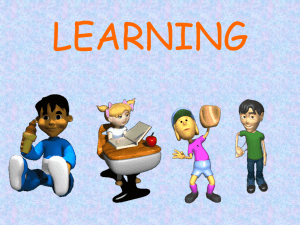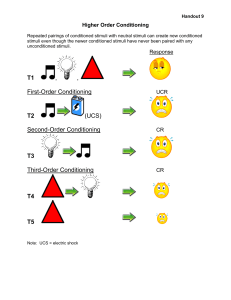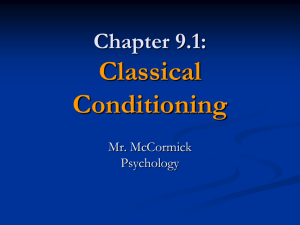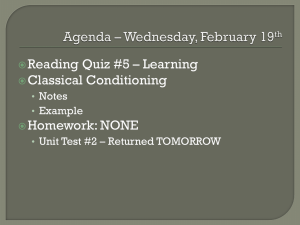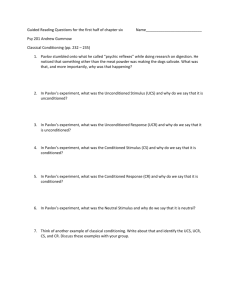Classical Conditioning
advertisement
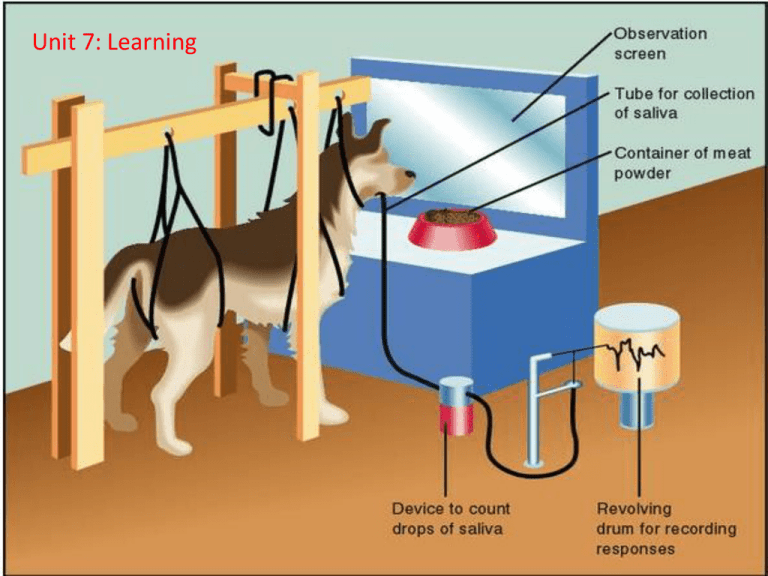
Unit 7: Learning Learning is what makes us human. • Adaptability – Ability to cope with new and changing circumstances • Does history always repeat itself? Can we change the course we’re on? • Idea underlies all therapy Learning is the heart of: Behaviorism • Belief that behavior is learned – genetics has little to do with it. • “nurture-only” belief, mainstream1960s and 70s. • Behaviorists believed learning done through associations. – Create habits (relating behavior to expected outcomes) • Behaviorists want psychology to be a science: – observable, testable and measurable. Attributes of Learning A. Learning = relatively permanent change in behavior or knowledge as a result of experience B. Distinction between learning and performance • Performance is an exhibited behavior • Learning can be inferred from performance, but performance is not always an accurate measure of learning C. Learning is adaptive – Unlike most species whose behavior and bodies have adapted to a certain environment – humans have the capacity to learn – Increase in speed of adaptation in comparison • Learning and thinking (cognition) have allowed us to adapt to all environments on earth, without our bodies changing. Learning IS Conditioning • Conditioning is the process of learned associations 1. Classical – associate 2 stimuli to anticipated events 2. Operant – associate a response (behavior) and its consequence • Repeat the good ones, avoid the bad ones 3. Observational – learn from others’ experiences and link to our own associations Classical Conditioning • Ivan Pavlov: Classical Conditioning. http://www.youtube.com/watc h?v=nE8pFWP5QDM Pavlov (early 20th century) influenced Watson • Watson is the father of behaviorism – Little Albert experiment “psychology should be an objective science based on observable behavior” • They ignored mental processes, but today we know that consciousness is important Definitions 1. Classical conditioning: learning that takes place when originally neutral stimulus comes to produce a conditioned response because of its association with an unconditioned stimulus • In other words – CREATING A REFLEX 2. An unconditioned stimulus (UCS or US) produces an unconditioned response (UCR or UR), even in the absence of previous training 3. A conditioned stimulus (CS) is a stimulus that has come to elicit a conditioned response (CR) because the organism associates the conditioned stimulus with the unconditioned stimulus - Initially called the “neutral stimulus” So let’s go back to Jaws… Pavlov’s Classical Conditioning: Pavlovian Response or “Psychic Reflex” • accidental psychologist: studying digestion initially • theory links to emotion, temperament, neuroses, and language Pavlov’s Experiment Unconditioned vs. Conditioned Responses • In Pavlov’s demonstration UR = CR – Salivation • Although UR and CR consist of same behavior, there are subtle differences – CR usually weaker or less intense • Sometimes UR and CR are different but related – Animal given a shock, UR = pain, CR = fear of imminent pain Conditioned Reflex • Classically conditioned responses described as reflexes – Involuntary and automatic Taste aversions? Trials • How long does it take to learn something? Classical Conditioning Applications 1. Conditioned Fear and Anxiety • • Phobias Irrational fear due to classical conditioning • • Fear of dentist drill Careful though – susceptibility of irrational fear is mostly based on genetics… how? Common Fears based on association 2. Emotional Responses – Arousal • Smell of first love’s cologne/perfume 3. Physiological Responses • Sexual arousal in quails – Conditioned to become aroused by nonsexual stimuli – Conditioned to elicit increased sperm release – Fetishes for inanimate objects • Difficult to test connections to human sexual fetishes Acquisition: initial stage of learning something 1. Involves repeated pairings of the CS and the UCS/US Acquisition Paradigms (patterns) • What are the different ways in which the initial learning can take place? a. Trace Conditioning – – – – – CS is presented and terminated BEFORE presentation of the UCS/US Conditioning often effective when the interval BETWEEN presentation of the CS the UCS/US is about a half second Fear studies; dependent on usage of hippocampus http://www.youtube.com/watch?v=PsGjh6ul7mE b. Delay Conditioning – when CS is presented and continues at least until the UCS/US is presented – Often times paired with trace conditioning in studies – Hippocampus-independent – Fear expression Fear Expression in Rats c. Simultaneous Conditioning – Occurs when CS and the UCS/US are presented and terminated at the same time – Anti-smoking ads d. Backward conditioning – Occurs when the UCS/US is presented before the CS – http://www.youtube.com/watch?v=fT6IWAIf580 e. Temporal conditioning – Occurs when CS is at a fixed period of time between presentations of the UCS/US • i.e. dog starts to salivate at 7:59am because s/he is fed at 8am everyday Extinction 1. A procedure that leads to gradual weakening and eventual disappearance of CR • Involves repeatedly presenting CS without pairing it with UCS/US Spontaneous Recovery 1. Occurs when previously extinguished CR suddenly reappears after a period of training 2. Renewal effect • • response will reappear if animal is returned to original environment where acquisition took place Proves that extinction is a suppression not an erasure (unlearning) • Explains drug abuse and relapse and difficulty getting rid of phobias permanently Classical Conditioning II A. Generalization 1. CR occurs to stimuli similar to the CS • even though these stimuli may have never been associated with the UCS 2. The more similar the stimuli are to the CS, the greater likelihood of generalization – Ex: Pavlov’s dogs salivating at a different tone than in training John Watson and Generalization • Little Albert – sight of white rat (CS) was paired with loud noise (UCS) until the CS alone produced crying and other responses indicative of fear • Ethical issues with Little Albert – Never heard from again – Failure to ensure no lasting ill effects B. Discrimination 1. stimuli similar to the CS does not produce a CR 2. The less similar new stimuli are to the original CS, the greater the likelihood of discrimination • What happens to generalization gradient when an organism learns a discrimination? How are discrimination and generalization similar? Different? Higher-Order Conditioning 1. A CS functions as if it were a UCS • Result: classical conditioning does not depend on natural US (remember the sexy quails?) Higher-Order Conditioning E. Factors that Affect Conditioning 1. Contiguity: The closer two stimuli are in space and time, the stronger the association between them. ------------------------------------------------------------------2. “Belongingness”: The “fit” between CS and US 3. Contingency: “Information value.” The higher the correlation between two stimuli, the stronger the conditioned response. 4. Salience: More intense or noticeable stimuli condition more rapidly. 1. Contiguity model • • Argues conditioning will occur whenever CS and UCS are paired Based on Pavlov 2. CS-US belongingness: not all CS’s and US’ associable 3. Contingency model • Argues CS must reliably predict UCS for conditioning to occur – based on work of Rescorla and Wagner (took indepth look at each trial of conditioning) – Supported by phenomena like blocking (Kamin) • Multiple CS tests, results? Contingency Phenomena • US pre-exposure effect: Presenting the US repeatedly prior to CS-US trials slows acquisition. • CS pre-exposure effect: Presenting the CS repeatedly prior to CS-US trials retards acquisition. (a.k.a. Latent Inhibition) Leon Kamin: Blocking • US has to be “surprising” for association to occur – Selective attention and learning 4. Salience effects • Overshadowing – in compound or higher order conditioning, the more salient CS wins One last one… d’oh • Test devaluation: critical period when stimulus/response has occurred too much, creating an adverse effect In Conclusion!! 2 models 1. Contiguity • Conditioning will occur when CS and UCS are paired 2. Contingency • CS must reliably predict UCS for conditioning to occur (there are a lot of things that could get in the way of that)

